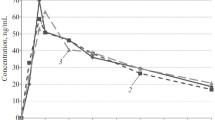Abstract
The D2-dopamine receptor antagonist raclopride was administered to eight healthy male subjects, who had previously experienced akathisia following antipsychotic drugs. The influence of administration rate on onset, severity and duration of akathisia and on prolactin response was studied. Raclopride 3,5 or 9 mg or placebo (P) was administered as single IV infusions during 10 min (R10 min/3 mg), 1 h (R1h/5 mg) or 4 h (R4h/9 mg) according to a randomized double-blind design. Despite a 24-fold difference in administration rate a similar peak raclopride concentration of about 350 nmol/l was obtained after all three infusions. Three of the eight subjects experienced akathisia following R10 min/3 mg and R1h/5 mg, respectively. After R4h/9 mg seven subjects experienced akathisia of longer duration but not more severe than after the short infusions. The incidence and duration of akathisia seem to be mainly related to the plasma raclopride concentrations over time, whereas the rate of administration might be more important for the severity. A maximal prolactin response was induced which was not markedly affected by the rate of administration.
Similar content being viewed by others
References
Adler LA, Angrist B, Reiter S, Rotrosen J (1989) Neuroleptic-induced akathisia: a review. Psychopharmacology 97:1–11
Barnes TRE (1989) A rating scale for drug-induced akathisia. Br J Psychiatry 154:672–676
Farde L (1992) Selective D1- and D2- dopamine receptor blockade both induces akathisia in humans—a PET study with [11C]SCH 23390 and [11C]raclopride. Psychopharmacology 107:23–29
Farde L, Hall H, Ehrin E, Sedvall G (1986) Quantitative analysis of D2 dopamine receptor binding in the living human brain by PET. Science 231:258–261
Farde L, Wiesel FA, Halldin C, Sedvall G (1988) Central D2-dopamine receptor occupancy in schizoprenic patients treated with antipsychotic drugs, Arch Gen Psychiatry 45:71–76
Farde L, Wiesel F-A, Jansson P, Uppfeldt G, Wahlén A, Sedvall G (1988) An open label trial of raclopride in acute schizophrenia, Confirmation of D2-dopamine receptor occupancy by PET. Psychopharmacology 94:1–7
Farde L, Von Bahr C, Wahlén A, Nilsson L, Widman M (1989) The new selective D2-dopamine receptor antagonist raclopride — pharmacokinetics, safety and tolerability in healthy males. Int Clin Psychopharmacol 4:115–126
Farde L, Nordström A-L, Wiesel F-A, Pauli S, Halldin C, Sedvall G (1992) Positron emission tomographic analysis of central D1 and D2 dopamine receptor occupancy in patients treated with classical neuroleptics and clozapine. Arch Gen Psychiatry 49:538–544
Gibaldi M, Perrier D (1982) Pharmacokinetics, 2nd ed. Marcel Dekker, New York
Köhler C, Hall H, Ögren S-O, Gawell L (1985) Specificin vitro and in vivo binding of3H-raclopride. A potent substituted benzamide drug with high affinity for dopamine D2-receptors in the rat brain. Biochem Pharmacol 34:2251–2259
Movin-Osswald G, Hammarlund-Udenaes M (1991) Remoxipride: pharmacokinetics and effect on plasma prolactin. Br J Clin Pharmacol 32:355–360
Movin-Osswald G, Nordström A-L, Hammarlund-Udenaes M, Wahlén A, Farde L (1992) Pharmacokinetics of raclopride formulations. Influence of prolactin and tolerability in healthy male volunteers. Clin Pharmacokinet 22:152–161
Nordström A-L, Farde L, Wiesel F-A, Forslund K, Pauli S, Halldin C, Uppfeldt G (1993) Central D2-dopamine receptor occupancy in relation to antipsychotic drug effects — a double blind PET study of schizophrenic patients. Biol Psychiatry 33:227–235
SAS Institute Inc. (1985a) SAS user's guide: basics, version 5, Edition. SAS Institute, Cary, NC
SAS Institute Inc. (1985b) SAS user's guide: statistics, version 5, Edition. SAS Institute, Cary, NC
Seeman P, Lee T, Chau-Wong M, Wong K (1976) Antipsychotic drug doses and neuroleptic/dopamine receptors. Nature 261:717–719
Von Bahr C, Wiesel F-A, Movin G, Eneroth P, Jansson P, Nilsson L, Ogenstad S (1991) Neuroendocrine responses to single oral doses of remoxipride and sulpiride in healthy female and male volunteers. Psychopharmacology 103:443–448
Author information
Authors and Affiliations
Rights and permissions
About this article
Cite this article
Movin-Osswald, G., Karlsson, P., Hammarlund-Udenaes, M. et al. Influence of rate of administration of raclopride on akathisia and prolactin response. Psychopharmacology 114, 248–256 (1994). https://doi.org/10.1007/BF02244845
Received:
Revised:
Issue Date:
DOI: https://doi.org/10.1007/BF02244845




